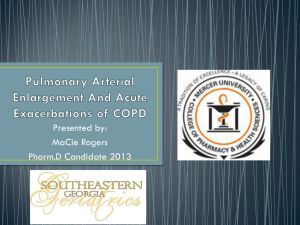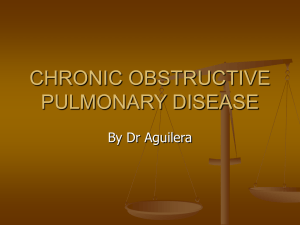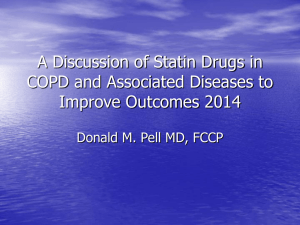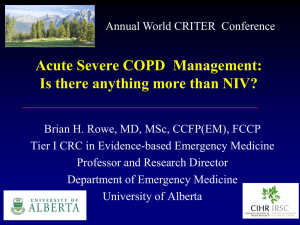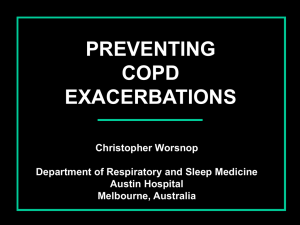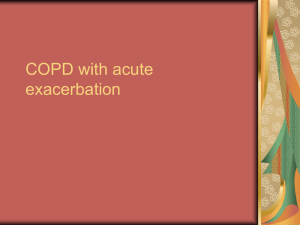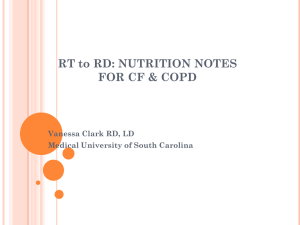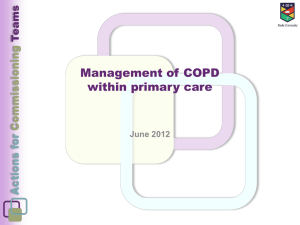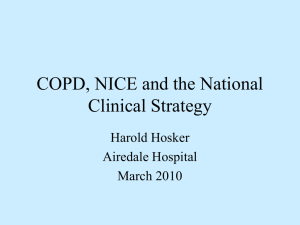EARLY TREATMENT - CHEST Delegation
advertisement
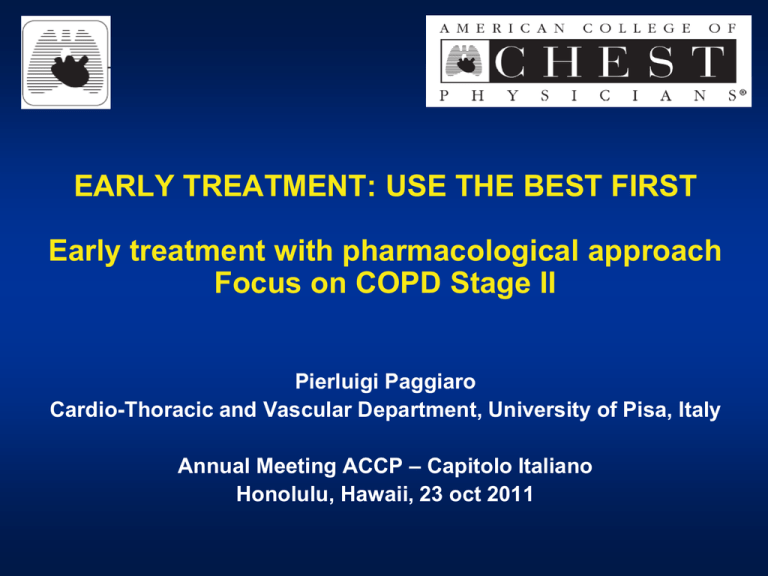
EARLY TREATMENT: USE THE BEST FIRST Early treatment with pharmacological approach Focus on COPD Stage II Pierluigi Paggiaro Cardio-Thoracic and Vascular Department, University of Pisa, Italy Annual Meeting ACCP – Capitolo Italiano Honolulu, Hawaii, 23 oct 2011 Main characteristics of COPD • Non completely reversible airway obstruction • Variable combination of chronic bronchitis and emphysema • Progressive decline in FEV1 • Progressive deterioration in – dyspnoea – exercise limitation • Relevant role of exacerbations – in progression of the disease – in quality of life The natural history of FEV1 decline in COPD patients Fletcher and Peto, BMJ 1977 Recent long-term trial have confirmed the progressive decline in FEV1 in untreated moderate-severe COPD Miravitlles et al, IJCOPD 2009 Long-term longitudinal studies have only partially confirmed the rate of FEV1 decline at different baseline FEV1 Decramer and Cooper, Thorax 2010 GOLD stage II has a greater FEV1 decline than GOLD stage III and GOLD stage IV Decramer and Cooper, Thorax 2010 Is it possible to modify the natural history of COPD ? • Several interventional studies – Lung Health Study I (ipratropium bromide) – ICS treatment • • • • Euroscope (budesonide) Copenhagen City Heart Study (budesonide) LHS II (triamcinolone) ISOLDE(fluticasone) – UPLIFT study (tiotropium) – TORCH study (Salm/Fluti) • Negative results in the primary outcome Long-term smoking cessation may modify the FEV1 decline Scanlon et al, AJRCCM 2000 Short and long-term studies with inhaled corticosteroids (ICS) • Effective in reducing number and/or severity of exacerbations – Several studies, with different but consistent results (Paggiaro et al, Lancet 1997) • Effect associated with: – Improvement in FEV1 – Improvement in quality of life – In subjects with FEV1 < 50% and frequent exacerbations • Studies over 3-4 years, with the aim to modify natural history of the disease – All studies negative on improving the progressive decline of FEV1 (Euroscop, ISOLDE, LHS-II, CCLS) – Confirmation of the positive effect on exacerbations and other secondary outcomes No effect of regular use ICS on FEV1 decline in COPD patients Soriano, Chest 2007 In the Uplift study, tiotropium induces an important improvement in FEV1 which persists over 4 years 1,50 Tiotropium * * FEV1 (L) 1,40 * * * * Control * 1,30 * * 1,20 * * * Post-Bronch FEV1 * = 47 – 65 mL * (n=2516) (n=2374) * * * 1,10 * (n=2494) Pre-Bronch FEV1 (n=2363) 1,00 0 01 Day 30 (steady state) 6 12 18 24 30 Month *P<0.0001 vs. control. Repeated measure ANOVA was used to estimate means. Means are adjusted for baseline measurements. Baseline trough FEV 1 (observed mean) = 1.116 (trough), 1.347 (peak). Patients with ≥3 acceptable PFTs after day 30 were included in the analysis. 36 42 48 = 87 – 103 mL Sub-analysis of the UPLIFT study • Different response to tiotropium, according to: – Gender: male vs female • Tashkin et al, Respir Med 2010 – Smoking habit: current vs ex vs intermittent • Tashkin et al, ERJ 2010 – GOLD II stage ** • Decramer et al, Lancet 2009 – Acute reversibility; reversible vs non reversible • Hanania et al, Resp Res 2011 – No additional therapies (ICS/LABA) ** • Troosters et al, ERJ 2010 – Age: lower than 50 yrs vs higher than 50 yrs ** • Morice et al, Respir Med 2010 Reversible and non reversible COPD patients had similar results from tiotropium addition Hanania et al, Resp Res 2011 In moderate COPD, tiotropium significantly reduces the decline in post-bronc FEV1 Decramer et al, Lancet 2009 Post-hoc analysis of TORCH study Salm/Fluti decreases the decline in FEV1 Celli et al, AJRCCM 2008 Rationale for early treatment in COPD • Symptoms and limitation in daily life – Present also in mild airway obstruction and/or hyperinflation • Decline in FEV1 – Greater in early phases – Positive effect of treatment easier to be observed • Airway and lung inflammation / exacerbations – Present in the early stages – More steroid-sensitive in early stage (?) • Need to identify “rapid decliners” May early treatment effectively prevent progressive deterioration in COPD ? Decramer et al, Respir Med 2011 Factors contributing to the progression of COPD • Persistence of smoking habit • Pulmonary function – FEV1 – IC • Exercise capacity – 6MWT, physical activity • Nutritional status – BMI, FFM • Rate of exacerbations COPD exacerbations represent an important outcome, among the PROs – COPD patients may have exacerbations, which increase in number and severity with the increase in the severity of the pathology of the disease – The impact of exacerbations increases over time, leading to: • Greater decline in pulmonary function 1 • Increase in symptoms 2 • Deterioration in health status 3 • Increased risk of hospitalization 4 – Severe exacerbations increase the risk of mortality 4,5 1. Donaldson GC et al. Thorax 2002; 57: 847-852; 2. Donaldson GC et al. Eur Respir J 2003; 22: 931-936; 3. Seemungal TA et al. Am J Respir Crit Care Med 1998; 157: 1418-1422; 4. Groenewegen KH et al. Chest 2003; 124: 459-467; 5. Soler-Cataluna JJ et al. Thorax 2005; 60: 925-931 Frequent exacerbations are related to a greater decline in FEV1 Donaldson et al, Thorax 2002 High frequency of exacerbations increases the risk of mortality in COPD 0 riacutizzazioni/anno ≥ 3 riacutizzazioni/anno 1–2 riacutizzazioni/anno Probabilità di sopravvivenza 1,0 0,8 p<0,0002 0,6 p<0,0001 0,4 p=0,069 0,2 0 0 10 20 30 40 50 60 Tempo (mesi) Soler-Cataluna JJ et al. Thorax 2005 ECLIPSE: 3-year longitudinal observational study 2165 COPD patients, GOLD II-IV baseline 3 Months 6 M V1 V2 V3 336 ‘healthy’ smokers 12 M V4 18 M V5 246 non smokers 24 M V6 30 M V7 36 M V8 Vestbo et al. ERJ 2008 Frequent exacerbators are represented in all GOLD stages Hurst et al, NEJM 2010 Frequent exacerbators represent a specific constant phenotype Hurst et al, NEJM 2010 Inhaled corticosteroids reduce the risk of exacerbations in COPD Alsaeedi et al, Am J Med 2002 Moderate-severe exacerbation in 3 yrs Mean number of exacerbation/year 1.2 1.13 25% reduction 0.97* 1 0.93* 0.85*†‡ 0.8 0.6 0.4 0.2 0 Placebo SALM FP SALM/FP Trattamenti *p < 0.001 vs placebo; †p = 0.002 vs SALM; ‡p = 0.024 vs FP Calverly et al, NEJM 2007 Salm/Fluti reduces all causes of mortality of COPD in comparison with placebo Calverly et al, NEJM 2007 “Asthma” pattern in COPD • Sputum eosinophilia • During acute exacerbations – In up to 50% of AE – Mainly in virus-induced AE • In stable COPD – In 30% about of patients – Associated with exhaled NO, acute reversibility (?) – Non associated with age, smoke, atopy, etc • Different response to inhaled or oral CS Virus-induced exacerbations of COPD are associated with greater sputum eosinophilia Papi et al, AJRCCM 2006 Sputum eosinophilia in stable COPD • Observed in up to 30-40% of patients • Lower than in asthma • Not related to other clinical features – Chronic bronchitis ? – Acute reversibility ? • How to select these patients ? High frequency of sputum eosinophils in COPD patients COPD patients with partial airway reversibility have higher levels of exhaled NO Papi et al, AJRCCM 2000 Sputum eosinophilia predicts a better response to CS in COPD patients Brightling et al, Thorax 2005 A strategy aiming to minimize sputum eosinophilia reduces the number of severe exacerbations of COPD Siva et al, ERJ 2007 Airway inflammation is present in COPD, also in earlier stages Hogg et al, NEJM 2004 Malondealdehayde (MDA), a marker of oxidative stress in EBC, is increased in stable moderate COPD patients Bartoli et al, Med Inflamm 2011 Conclusions • Progression of COPD is more evident in early phase – In GOLD I-II stages • Exacerbations represent a major target of treatment – Efficacy of ICS and ICS/LABA – Also in earlier stages • Early treatment – Better chance of modifying natural history • Phenotyping of COPD – “asthmatic” feature role of ICS A more flexible approach, based on symptoms and exacerbations, and not only on FEV1, has been now considered in the future GOLD guidelines

